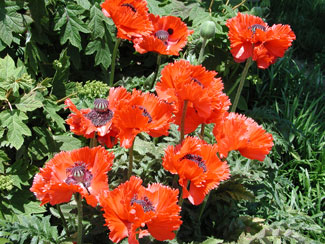Resource Library
Plant of the Week: Poppy, Oriental
The University of Arkansas System Division of Agriculture does not promote, support or recommend plants featured in "Plant of the Week." Please consult your local Extension office for plants suitable for your region.
Plant of the Week
Oriental Poppies
Latin: Papaver orientale

Of the garden perennials, none is as exotic and dare I say, sensual, as the Oriental poppy, Papaver orientale. The shockingly bright, usually orange or red, tissue-paper thin blooms as big as a cereal bowl are stunning to those of us attracted to things that are big, bold and garish. If they were easier to grow in the South, they would be more common in our gardens.
Papaver orientale is a member of the poppy family and the first species cultivated in European gardens but it is only one of three species used in creating the modern garden hybrids. The hybrids are taprooted herbaceous perennials that, in a colder climate and given a good site, can live for decades. The species are native to Western Asia in Iran, northern Turkey and the Caucuses in areas that are wet and cold in the winter and hot and dry in the summer.
Modern hybrids are around 3 feet tall though breeders are striving for more compact
forms that do not require staking. The solitary flowers are usually around 6 inches
across with tissue-paper-thin petals in shades of orange, red, pink, lavender or white
that may or may not be marked with a large basal blotch of black. The inner portion
of the flower is comprised of a dense concentric ring of black stamens surrounding
a large, flat topped but bulbous ovary. The Oriental poppies do not produce the alkaloids
that are the precursors to opium.
Oriental poppy foliage is mostly basal and somewhat thistle-like in appearance. Leaves
are hairy, sometimes silvery, about a foot long and much dissected. The foliage usually
appears in the fall with the arrival of cooler weather and rain but disappears shortly
after flowering in early summer.
Papaver orientale was the first species brought into cultivation about 1702 when the French botanist Joseph de Tournefort (1656 -1708) returned from his two-year exploration of the Eastern Mediterranean, Turkey and modern day Georgia, the country, not the state. Papaver pseudo-orientale was in cultivation by 1788 with P. bracteatum following in 1817. These species closely resemble one another but the last species is clump forming and more erect with the largest flowers while the first two have a suckering habit of growth. The true Oriental poppy has a bare stem and a down-turned bud prior to blooming while P. pseudo-orientale has leaves up the stem and an erect flower bud. Traces of the characteristics of the original species can still be seen in modern hybrids.
Modern Oriental poppy breeding began in 1906 when English nurseryman Amos Perry (1871-1953) selected a salmon pink-flowered form and introduced it as ‘Mrs. Perry’. He went on to introduce a total of 11 new cultivars in a range of colors and these lead the way to the array of pastel colors we see offered today.
Oriental poppies are reportedly hardy from zones 3 through 8, but if you look at where people live that are commenting on their performance on the Web, most garden in zones 3 through 6. They like a cool, moist, slightly acidic to slightly alkaline soil that is well drained. In a cool climate they are best in full sun but in the south a location on the north side of the house, on a north facing slope or in an area with afternoon shade is preferable. Once established they resent root disturbance or lifting so keep this in mind before planting. Avoid crowding with overly competitive perennials even though they disappear during the summer months.
Poppies as a group resent being transplanted so new plants can be grown from seed planted in late fall where they are to grow. Because poppy seed needs light for germination, make sure seeds aren’t covered by leaves or other debris before seedlings emerge in spring. Container grown plants are sometimes available but be sure to handle the root ball carefully to not disturb it when planting.
By: Gerald Klingaman, retired
Retired Extension Horticulturist - Ornamentals
Extension News - March 1, 2013
The University of Arkansas System Division of Agriculture does not maintain lists of retail outlets where these plants can be purchased. Please check your local nursery or other retail outlets to ask about the availability of these plants for your growing area.